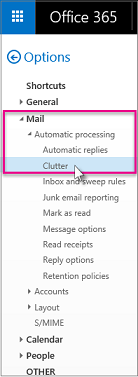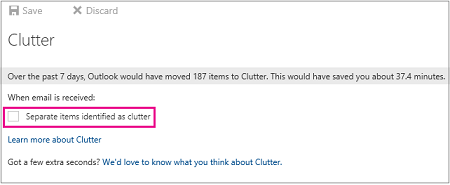Use Clutter to sort low priority messages in Outlook 2016 for Mac
Clutter moves your low priority messages out of your Inbox so you can easily scan for important messages. Clutter analyzes your email habits, and based on your past behavior, it determines the messages that you're most likely to ignore. It then moves those messages to a folder called Clutter, where you can review them later.
Important: In order to use Clutter, you'll need:
-
An email account on an Exchange server.
-
Office 365.
Find the Clutter folder
-
In Outlook 2016 for Mac, in the left pane select your Exchange account. It might be named after your organization, e.g., Contoso.
-
Select the Clutter folder to see your messages.

I don't see Clutter in the list. If you don't see Clutter in your folder list, it might be because Clutter hasn't been turned on. See Turn Clutter on for instructions.
Turn Clutter on
The setting for turning Clutter on and off is in Office 365 so you'll need to sign in to Outlook on the web with your work or school account.
-
In Outlook on the web, click Settings
 > Mail.
> Mail. -
In the left pane, under Options, click Mail > Automatic processing > Clutter.

-
In the right pane under Clutter, select Separate items identified as clutter, and then click Save.

Turn Clutter off
-
In Outlook on the web, click Settings
 > Mail.
> Mail. -
In the left pane, under Options, click Mail > Automatic processing > Clutter.

-
In the right pane under Clutter, clear the checkbox next to Separate items identified as clutter, and then click Save.

Help Clutter learn your preferences faster
Clutter and junk email are both filtered before they reach your Inbox. Messages identified as possible junk email are automatically moved to the Junk Email folder, and any potentially dangerous content, for example links or attached programs, are disabled. Then Outlook processes the rules, if you have set up any. For more information about rules, see Create a rule in Outlook 2016 for Mac.
Next, Clutter analyzes the remaining messages and filters the types of messages that you usually ignore or don't respond to, based on your past behavior.
Messages from certain people will never be identified as clutter:
-
You
-
Anyone in your management chain, if you're an Office 365 business user.
-
Your direct reports, if you're an Office 365 business user.
Clutter looks at various aspects of messages to understand what you don't typically read them, for example:
-
The sender
-
Whether you've participated in the conversation
-
Whether you're the only recipient
-
The importance
As your reading habits change, Clutter learns and adapts. It might take Clutter a few days to fully adapt to your preferences, as the system tracks your choices and uses the information to identify similar messages in the future. But you can help Clutter learn your choices faster:
-
If you see a message that was sent to your Clutter folder by mistake, select the email and drag it to your Inbox or another folder in your Inbox.
-
If you see a low priority email in your Inbox, select and drag it to the Clutter folder.
No comments:
Post a Comment